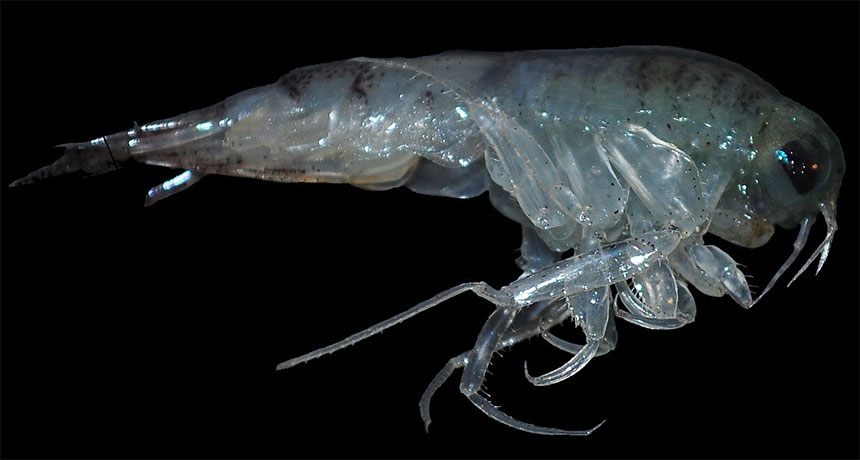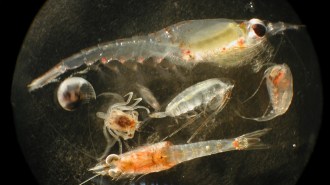Sea ice algae drive the Arctic food web

Even organisms that live in open waters of the Arctic, such as this Themisto libellula amphipod, get a lot of their carbon from algae that live in sea ice, a new study finds.
Angelina Kraft/Alfred-Wegener-Institut
- More than 2 years ago
As happens every summer, sea ice in the Arctic is shrinking as temperatures warm. But this year is a particularly warm year, and there is less sea ice than there usually is. Scientists say Earth is on track to matchor perhaps even exceed the record low extent of summertime sea ice seen in September 2012.
The disappearing sea ice is a symptom of a warming planet, and it is also a problem for organisms associated with the ice, such as algae that live in the brine-filled channels within sea ice. “These algae are adapted to grow under very low light conditions,” says Doreen Kohlbach of the Alfred Wegener Institute in Bremerhaven, Germany. These algae, along with algal species that live in the open ocean, form the base of the Arctic food web. And they are an important food source even for species that don’t live under the ice, a new study shows.
This indicates that climate change will not only affect organisms with a close connection to the sea ice, Kohlbach says, but it will also subsequently affect the pelagic, or open-ocean, system.
In the new study, Kohlbach and her colleagues looked at the percentage of carbon that various species of zooplankton — one step up on the Arctic food web — get from sea ice algae during late summer. Some of the organisms live near the sea ice, while others are considered pelagic species. By using fatty acids as a marker, the researchers determined how much carbon in each species came from sea ice algae.
Animals that lived beneath the sea ice, not surprisingly, got a lot of their carbon from sea ice algae — from 60 to 90 percent, the researchers report July 8 in Limnology and Oceanography. But even pelagic species obtained 20 to 50 percent of their dietary carbon from algae embedded in sea ice. “Our results showed that not only the ice-associated animals were living mainly from ice algae–produced carbon, but that also the pelagic species showed a significant dependency on ice algae–produced carbon,” says Kohlbach.
Scientists have yet to test higher levels of the food web, so they can’t yet predict how the loss of sea ice algae might affect larger species, such as fish or seals or polar bears. But it will probably have some effect, Kohlbach says. “If alterations of the sea ice system affect the low members of the food chain, it will consequently affect all following members.”
There’s also a chance that species that currently feed on sea ice algae could switch to feeding on other species if their preferred food disappears. But the concern is for those species that depend entirely on sea ice algae. “We cannot say for sure what will happen to the organisms that depend highly on sea ice,” Kohlbach says. Some of them might adapt to the changes with a changing feeding behavior. To determine the consequences on a species-level, we need to do more research.”




